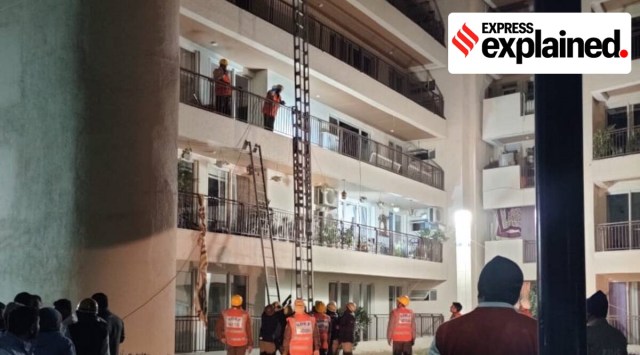Gurgaon collapse: What you should know about building safety standards
Two people were killed and several others injured last week when a portion of a flat on the 6th floor collapsed at a housing complex in Gurgaon. How do you know if a house is safe or not?
 A portion of a flat on the 6th floor collapsed at Chintels Paradiso housing complex in Gurgaon's Sector 109. (Express photo)
A portion of a flat on the 6th floor collapsed at Chintels Paradiso housing complex in Gurgaon's Sector 109. (Express photo)Two people were killed and several others injured on Thursday (February 10) when a portion of a flat on the 6th floor collapsed at Chintels Paradiso housing complex in Gurgaon’s Sector 109. The incident happened when the slab of the flat that was under renovation collapsed all the way down to the first floor. The incident has raised apprehensions regarding safety standards of multi-story residential buildings.
How to know if a house is safe or not?
The first way to know if a house is safe is to check the certification given by the respective authority to the builder after construction – for instance, the certificates given by municipal corporations or development authority of respective states.
Every state has building bylaws that have to be followed during the time of construction and it is the role of the authorities to ensure that. These bylaws cover aspects like ground coverage, floor area ratio, material used as per the soil requirement, tensile strength, beam and column strength, height restrictions as per the seismic zone. Thereafter, one can check whether National Building Code of India (NBC), a comprehensive building code for regulating the building construction activities across the country, has been followed or not. It serves as a Model Code for adoption by all agencies involved in building construction works, be they Public Works Departments, other government construction departments, local bodies or private construction agencies.
Does this guarantee that a house is safe or not?
“No,” said a senior official of South Delhi Municipal Corporation and added, “It is possible that a builder has not followed the rules but managed to get completion certificates.” This involves unfair means but is hard to ascertain.
He said that the building generally collapses if it is under or over reinforced. An over reinforced construction is the one in which concrete is used for compressive strength. “In simple words, it has more steel and less concrete. This kind of beam leads to sudden collapse and such construction is not allowed,” he said. An under reinforced beam construction is one in which steel is less than required and will show indications like cracks or a portion of concrete falling.
How to prevent accidents in cases when there are no visible signs?
There can be a structural safety audit and test conducted of a building, that includes design load test, soil settlement test, beam and column strength test, sample collection of portions of a building from different areas to identify whether a building is safe or not. These tests are conducted mainly by National Council for Cement and Building Materials, Rail India Technical and Economic Service, Indian Institute of Technology and other agencies. However, these are very costly tests and one has to end up paying lakhs. “This is done mostly in cases of government buildings, housing societies and not for individual houses due to high prices of the tests,” said a senior East MCD official.
What is the solution for individual houses in cases where there are visible signs?
In cases of individual houses, one can get the house or building checked by the structural engineers. “However, these checks are at a surface level. The expert checks the design, balance of load on pillars and cracks, but would not be able to detect the quality of material used,” said a senior EDMC official. “This is not a fool proof method but an expert can definitely use his experience to warn if there are visible signs of building being unsafe and can give solutions to correct the structure balance,” he said.
Newsletter | Click to get the day’s best explainers in your inbox






- 01
- 02
- 03
- 04
- 05

































